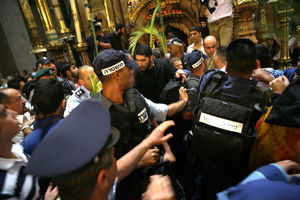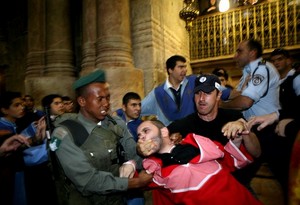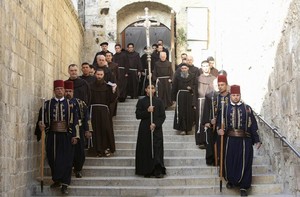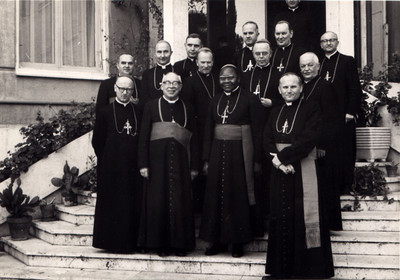Edward Pentin writing for Terrasanta.net tries to contextualize the rather distasteful events among “Christians” at the Church of the Holy Sepulchre earlier in the month. I am still trying to wrap my mind around the complexities that exist in the Holy Land. Certainly, there are many and not easy to sort out. But the scandal of these “ecclesial acts” by betray the fragility of faith and lack of engagement in the spiritual life. For the life me I can’t help but think these monks have abandoned faith and salvation in Christ and yet persist in living as monks, at least on the superficial level.
Saint Rose Philippine Duchesne
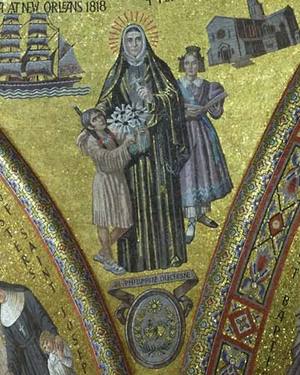 Gracious God, You filled the heart of Rose Philippine Duchesne with charity and missionary zeal, and gave her the desire to make you known among all peoples. Fill us, who honor her memory today, with that same love and zeal to extend your kingdom to the ends of the earth.
Gracious God, You filled the heart of Rose Philippine Duchesne with charity and missionary zeal, and gave her the desire to make you known among all peoples. Fill us, who honor her memory today, with that same love and zeal to extend your kingdom to the ends of the earth.
Saint Rose Philippine immigrated to the USA and was a missionary on the North American frontier. As a member of the Society of the Sacred Heart she founded convents of her order, schools and ministered to a variety of peoples. If it weren’t for her help the Jesuits would not have succeeded in settling in Missouri. Her shrine is near St. Louis, MO.
A brief note is read here.
Advent in the Maronite Church
Do you know if Advent’s begun? It has if you are a Maronite Catholic. The typical 4 week Advent season for many Catholics of the Latin Church is not the norm for all Catholics.
 Season of the Glorious Birth of the Lord
Season of the Glorious Birth of the Lord
(Season of soboorey, or “Happy Announcements”)
 The pre-Christmas Cycle has six Sundays, which all focus on the unfolding revelation of the Birth of the Messiah. This is done in the context of the immediate family of Jesus, centering on Mary and Joseph (Matthew 1, 2; Luke 1, 2). This is certainly in line with the Antiochene emphasis on the humanity of Jesus and its appreciation of the historical aspect of Scripture. The greatest Announcement, of course, is that of the angels on Christmas.
The pre-Christmas Cycle has six Sundays, which all focus on the unfolding revelation of the Birth of the Messiah. This is done in the context of the immediate family of Jesus, centering on Mary and Joseph (Matthew 1, 2; Luke 1, 2). This is certainly in line with the Antiochene emphasis on the humanity of Jesus and its appreciation of the historical aspect of Scripture. The greatest Announcement, of course, is that of the angels on Christmas.
There are one or two Sundays after Christmas (depending upon the day of the week that Christmas occurs), one of which is always celebrated: the Finding in the Temple. On 1 January the liturgical commemoration is Feast of the Circumcision (Naming) of the Child Jesus, with a second commemoration of the common Eastern observance of Saint Basil.
The Sundays of the Advent Season in the Maronite Church are:
- Announcement to Zechariah
- Announcement to the Virgin Mary
- Visitation to Elizabeth
- Birth of John the Baptizer
- Revelation to Joseph
- Genealogy Sunday
- The Finding in the Temple
In celebrating the Finding in the Temple (Sunday after Christmas) the Maronite Church uses the 3rd Infancy Narrative of Luke (chapter 2) to parallel closely the Gospel development of Jesus’ own growth. He is seen in the Temple, recognizing his true “Father” (his divine Origin) and preparing himself for his Baptism and public life. In addition, Joseph disappears from all the Gospel narratives: Joseph’s earthly fathering is done, and Jesus will now proclaim the heavenly Father. The Twelve Days of Christmas take us to the Feast of the Epiphany (Theophany).
Season of Epiphany (in Syriac this feast is called Denho)
 Taking the Baptism of Jesus (6 January) as the model, the Maronite Church celebrates our new life of Baptism and Chrismation in this Season. In Syriac it is called denho. For some Syriac Churches, this season is the traditional time of reception of catechumens into the Church. But for all Syriac Christians, denho is a time to reflect on our baptism. During the first three days of the Sixth Week of Epiphany (Monday-Wednesday) the Maronite Church observes “Nineveh Days.” These three days are penitential and serve to anticipate the Season of Great Lent. In one form or another, these days are observed by all the Syriac Churches, East and West.
Taking the Baptism of Jesus (6 January) as the model, the Maronite Church celebrates our new life of Baptism and Chrismation in this Season. In Syriac it is called denho. For some Syriac Churches, this season is the traditional time of reception of catechumens into the Church. But for all Syriac Christians, denho is a time to reflect on our baptism. During the first three days of the Sixth Week of Epiphany (Monday-Wednesday) the Maronite Church observes “Nineveh Days.” These three days are penitential and serve to anticipate the Season of Great Lent. In one form or another, these days are observed by all the Syriac Churches, East and West.
(Thanks to R. Dom Bartholomew Leon, OSB, Saint Rafka Mission, Greenville, SC)
Saint Gertrude the Great
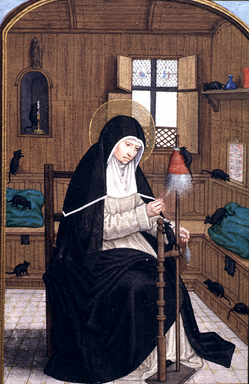 O God, Who in the most pure heart of blessed Gertrude Thy Virgin did prepare for Thyself a well-pleasing dwelling, mercifully efface all stains from our hearts, so that they may merit worthily to be made the dwelling place of Thy divine majesty.
O God, Who in the most pure heart of blessed Gertrude Thy Virgin did prepare for Thyself a well-pleasing dwelling, mercifully efface all stains from our hearts, so that they may merit worthily to be made the dwelling place of Thy divine majesty.
Saint Gertrude was not drawn to the Heart of Jesus as much as through the Heart of Jesus, to the Father, in the Holy Spirit. Her prayer is essentially Trinitarian. Her whole being is oriented ad Patrem, and this because she is united to the Son, because she has entered through the pierced Heart of the Son as through an open door, oriented and carried as it were, by the breath of the Holy Spirit.
Saint Gertrude reminds us that the entire liturgy is Trinitarian: every detail, the smallest word or gesture in the sacred liturgy is a contact with Christ. In the liturgy, nothing is insignificant. Everything is invested with sacramentality, that is, with the potential to unite us to Christ, so that through Him and with Him we might pass into the fiery embrace of the Holy Spirit and the bosom of the Father. Saint Gertrude reminds us that the liturgy — the Eucharist and other the sacraments, but also the Liturgy of the Hours — is more than a complex of words and chants, rites and gestures. (courtesy of MDMK)
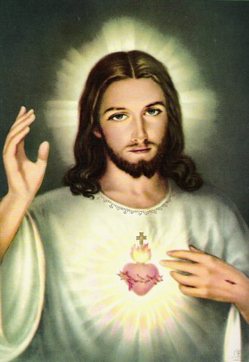 Saint Gertrude’s Prayer to the Sacred Heart of Jesus
Saint Gertrude’s Prayer to the Sacred Heart of Jesus
Hail! O Sacred Heart of Jesus, living and quickening source of eternal life, infinite treasure of the Divinity, and burning furnace of divine love. You are my refuge and my sanctuary, O my amiable Savior.
Consume my heart with that burning fire with which Yours is ever inflamed. Pour down on my soul those graces which flow from Your love, and let my heart be so united with Yours, that our wills may be one, and mine in all things, be conformed to Yours. May Your divine will be equally the standard and rule of all my desires and of all my actions. Amen.
Saint Gertrude on friendship
One day between Easter and Ascension I went into the garden before [Office of] Prime, and sitting down beside the pond, I began to consider what a pleasant place it was. I was charmed by the clear water and flowing streams, the fresh green of the surrounding trees, the birds flying so freely about, especially the doves. But most of all, I loved the quiet, hidden peace of this secluded retreat.
I asked myself what more was needed to complete my happiness in a place that seemed to me so perfect, and I reflected that it was the presence of a friend, intimate, affectionate, wise, and companionable, to share my solitude.
From the Heart of God: Vatican II & Pope John Paul II
 On October 28, 2008, Pope Benedict wrote to Most Reverend Father Marco Tasca Minister General of the Friars Minor Conventual and Grand Chancellor of The Pontifical Theological Faculty of St Bonaventure Seraphicum on the occasion of an institute dealing with the theme of “The Second Vatican Council in the Pontificate of John Paul II.” Here are a few relevant paragraphs from His Holiness:
On October 28, 2008, Pope Benedict wrote to Most Reverend Father Marco Tasca Minister General of the Friars Minor Conventual and Grand Chancellor of The Pontifical Theological Faculty of St Bonaventure Seraphicum on the occasion of an institute dealing with the theme of “The Second Vatican Council in the Pontificate of John Paul II.” Here are a few relevant paragraphs from His Holiness:
I can only rejoice at the choice of a theme that unites two topics of quite special interest to me: on the one hand, the Second Vatican Council, in which I had the honour of taking part as an expert and on the other, the figure of my beloved Predecessor John Paul II who made a significant personal contribution to that Council as a Council Father and subsequently, by God’s will, became its first executor during the years of his Pontificate. In this context it seems only right also to recall that the Council sprang from the great heart of Pope John XXIII, the 50th anniversary of whose election to the Chair of Peter we are commemorating today, 28 October. I said that the Council sprang from John XXIII’s heart, yet it would be more accurate to say that ultimately, like all the great events in the Church’s history, it came from the Heart of God, from his saving will: “God so loved the world that he gave his only Son, that whoever believes in him should not perish but have eternal life” (Jn 3: 16). To make divine salvation accessible to contemporary man was Pope John XXIII’s main reason for convoking the Council, and the Fathers worked with this in mind. For this very reason, “As the years have passed, the Conciliar Documents” as I recalled on 20 April 2005, the day after my election to the Pontificate, “have lost none of their timeliness; indeed, their teachings are proving particularly relevant to the new situation of the Church and the current globalized society” (Message to Cardinals, 20 April 2005).
 In practically all his documents, and especially in his decisions and his behaviour as Pontiff, John Paul II accepted the fundamental petitions of the Second Vatican Council, thus becoming a qualified interpreter and coherent witness of it. His constant concern was to make known to all the advantages that could stem from acceptance of the Conciliar vision, not only for the good of the Church but also for that of civil society itself and of the people working in it. “We have contracted a debt to the Holy Spirit”, he said in his Reflection prior to the Angelus on 6 October 1985, referring to the extraordinary session of the Synod of Bishops which was about to be celebrated precisely in order to reflect on the Church’s response during the 20 years that had passed since the conclusion of the Second Vatican Council. “We have contracted a debt to the Spirit of Christ…. This, in fact, is the Spirit who speaks to the Churches (cf. Rv 2: 7); during the Council and by means of it, his word has become particularly expressive and decisive for the Church” (ore, 14 October 1985, p. 12).
In practically all his documents, and especially in his decisions and his behaviour as Pontiff, John Paul II accepted the fundamental petitions of the Second Vatican Council, thus becoming a qualified interpreter and coherent witness of it. His constant concern was to make known to all the advantages that could stem from acceptance of the Conciliar vision, not only for the good of the Church but also for that of civil society itself and of the people working in it. “We have contracted a debt to the Holy Spirit”, he said in his Reflection prior to the Angelus on 6 October 1985, referring to the extraordinary session of the Synod of Bishops which was about to be celebrated precisely in order to reflect on the Church’s response during the 20 years that had passed since the conclusion of the Second Vatican Council. “We have contracted a debt to the Spirit of Christ…. This, in fact, is the Spirit who speaks to the Churches (cf. Rv 2: 7); during the Council and by means of it, his word has become particularly expressive and decisive for the Church” (ore, 14 October 1985, p. 12).
We are all truly indebted to him for this extraordinary ecclesial event. The multiple doctrinal legacy that we find in its Dogmatic Constitutions, Declarations and Decrees still stimulates us to deepen our knowledge of the Word of God in order to apply it to the Church in the present day, keeping clearly in mind the many needs of the men and women of the contemporary world who are extremely in need of knowing and experiencing the light of Christian hope. The Synod of Bishops that has just ended placed these needs at the centre of its own rich and fruitful reflections, reaffirming the hope expressed in the past by the Constitution Dei Verbum: “So may it come that, by the reading and study of the sacred books, “the Word of God may speed on and triumph’ (2 Thes 3: 1), and the treasure of the Revelation entrusted to the Church may more and more fill the hearts of men” (n. 26), bringing them the salvation of God and with it authentic happiness.
This is a commitment that I am pleased to entrust in particular to you, dear Professors of the Pontifical Theological Faculty, who venerate the Seraphic Doctor St Bonaventure as its heavenly Patron. In the wealth of his thought, St Bonaventure can offer interpretative keys which are still up-to-date and with which you may approach the Conciliar Documents to seek in them satisfactory answers to the many questions of our time. The anxiety for humanity’s salvation which motivated the Council Fathers, guiding their commitment in the search for solutions to the numerous problems of the day was equally alive in St Bonaventure’s heart as he faced the hopes and anguish of the people of his own time. On the other hand, since the basic questions that man carries in his heart do not change with the changing of times, the answers the Seraphic Doctor attained have remained substantially applicable also in our day. In particular, the Itinerarium mentis in Deum that St Bonaventure composed in 1259 has remained valid. Although it is a guide to the heights of mystical theology, this precious little book also speaks to all Christians of what is essential in their lives. The ultimate goal of all our activities must be communion with the living God. Thus, for the Fathers of the Second Vatican Council too, the ultimate aim of all the individual aspects of the Church’s renewal was to lead the faithful to the living God revealed in Jesus Christ.
International Meeting of Prayer for Peace sponsored by the Community of Sant’Egidio
The Civilization of Peace: Faiths and Cultures in Dialogue
 The meeting, which has been promoted by the Community of Sant’Egidio and the Church of Cyprus, takes place in Nicosia from 16 to 18 November.
The meeting, which has been promoted by the Community of Sant’Egidio and the Church of Cyprus, takes place in Nicosia from 16 to 18 November.
The Cyprus date is a further leg of the pilgrimage undertaken by the Community of Sant’Egidio to carry forward the legacy of the historic World Day of Prayer for Peace convened in Assisi by Pope John Paul II on October 27, 1986.
Over these twenty-two years, invitations from the Community have led men and women from diverse cultures and religions onto the pathway of encounter, dialogue and prayer for peace. The pilgrimage has called on various locations around the world, spreading the “Spirit of Assisi”, creating ties of friendship and cooperation, testifying to a common will to create a culture of coexistence.
On opening the last meeting, held in Naples in October 2007, Pope Benedict 16th stated: “In respecting the differences between the various faiths, we are all called upon to work for peace and to make a concrete effort to further reconciliation between nations. This is the authentic “Spirit of Assisi”… religions can and must offer a precious resource for constructing a peaceful humanity, because they speak of peace being at the heart of humankind”.
The Cyprus Meeting constitutes part of this commitment.
The island, lying at the heart of the Mediterranean, touched on by the preaching of St Paul the Apostle, place of encounter between a variety of cultures and religions, will host several hundred figures from every part of the world: representatives of the worlds of religion, of culture and of politics. They will enliven around 20 “round tables”, open – as is the tradition at these encounters – to participation by the public.
The Closing Ceremony will take place on November 18 in the heart of the capital, Nicosia; it will feature the proclamation the Appeal for Peace.
As in previous years, this site will follow the event via a live video web-link.
Christian-Muslim dialogue: working toward a common destiny or a waste of time?
The (C.I.S.R.O.) is a network of
 contacts that gives Christians and Muslims a chance to meet and promote mutual knowledge and understanding. Founded in September 2004 by the Patriarch of Venice, Angelo Cardinal Scola, as part of the Studium Generale Marcianum, the Centre sees itself as a venue for the exchange of experiences and points of view between people from different ecclesial realities (some churches in Europe and some Christian communities in predominantly-Muslim countries) and Muslims from various backgrounds.
contacts that gives Christians and Muslims a chance to meet and promote mutual knowledge and understanding. Founded in September 2004 by the Patriarch of Venice, Angelo Cardinal Scola, as part of the Studium Generale Marcianum, the Centre sees itself as a venue for the exchange of experiences and points of view between people from different ecclesial realities (some churches in Europe and some Christian communities in predominantly-Muslim countries) and Muslims from various backgrounds.
The Centre’s main field of interest is to examine how Christian and Muslim believers actually relate to and interact with one another for the purpose of building the “good life” in personal and social terms in a world like today’s world that is characterised by cross-cultural and intra-civilisational métissage.
A recent introduction to the Oasis journal read:
The first seminar of the Catholic-Muslim Forum belongs to a long line of meetings that have been promoted above all since the Declaration of the Second Vatican Council Nostra Aetate, a point of reference for inter-religious dialogue. The visit of John Paul II to the mosque of Damascus and the visit of prayer of Benedict XVI to the Blue Mosque of Istanbul remain emblematic.
 But the meeting of these days has two new features – one relating to method and the other to contents. At the level of method, the Forum appears on the Muslim side no longer as an initiative of individual personalities or States but as the expression of a general agreement. From the initial response to the Ratisborn address with its 38 signatories to the subsequent declaration A Common Word with the adherence of 138 personalities, which was subsequently expanded, the tendency on the Muslim side has been to achieve basic agreement to dialogue with Christians. This is not a secondary question because agreement for a large part of Muslim theology is one of the sources of the elaboration of doctrine.
But the meeting of these days has two new features – one relating to method and the other to contents. At the level of method, the Forum appears on the Muslim side no longer as an initiative of individual personalities or States but as the expression of a general agreement. From the initial response to the Ratisborn address with its 38 signatories to the subsequent declaration A Common Word with the adherence of 138 personalities, which was subsequently expanded, the tendency on the Muslim side has been to achieve basic agreement to dialogue with Christians. This is not a secondary question because agreement for a large part of Muslim theology is one of the sources of the elaboration of doctrine.
The second new feature is that in this Forum, as in the open letter, the emphasis has been placed in a decisive way on the religious dimension, if not even on the strictly theological dimension. In the communiqué that preceded this event one reads that the composition of the delegations is ‘religious and not political’, ‘is separate from the diplomatic relations of States and was constituted on the basis of sapiential authority’. Indeed, it is evident that the statement of principle contained in the open letter must be verified in the light of its concrete translation into a context which is increasingly difficult for Christian minorities, as the continuing exodus of Christians from the Middle East demonstrates. However, the wish of the two parties is not to dissolve the specificity of the religious fact into, albeit important, geopolitical considerations.
One of the moving spirits of Islamic-Christian dialogue, Father Georges Anawati, loved to repeat that in this field it was necessary to arm oneself with ‘geological patience’. It would, therefore, be illusory to imagine that wounds that go back more than a thousand years can be healed in the space of a few months. The aim of the Forum is to explore the affirmation of love of God and neighbour in its theological and spiritual aspects but also in relation to its practical consequences for the defence of the dignity of the human person and the defence of religious freedom. The fifteen points of the final document offer different points of departure in this direction. It is certainly the case that today there are many questions which must be answered, but for a believer the most burning question is perhaps the simplest one: do Muslims and Christians worship the same God? Without this mutual recognition everything becomes more difficult. The answer on the Catholic side is clear and was proposed by Lumen Gentium, in n. 16: ‘But the plan of salvation also includes those who acknowledge the Creator. In the first place amongst these there are the Mohamedans, who, professing to hold the faith of Abraham, along with us adore the one and merciful God, who on the last day will judge mankind’. This was an answer emphasised yesterday by Benedict XVI in his audience to the participants: ‘I am well aware that Muslims and Christians have different approaches in matters regarding God. Yet we can and must be worshippers of the one God who created us and is concerned about each person in every corner of the world’
On the Muslim side Seyyed Hossein Nasr stated: ‘For both us and you, God is at once transcendent and immanent, creator and sustainer of the world… the lover whose love embraces the whole of the created order’. This is the basic belief that inspires the continuation of dialogue.
All the articles and other documentation is archived here.
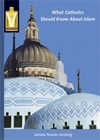 Also, you might want to read a good, brief introduction to the field of Catholic-Muslim theology, What Catholics Should Know about Islam by Dr. Sandra T. Keating published by the Catholic Information Service.
Also, you might want to read a good, brief introduction to the field of Catholic-Muslim theology, What Catholics Should Know about Islam by Dr. Sandra T. Keating published by the Catholic Information Service.
Benedictine All Souls
It is a treasured monastic tradition to pray for the dead, to visit the cemetery and to recall
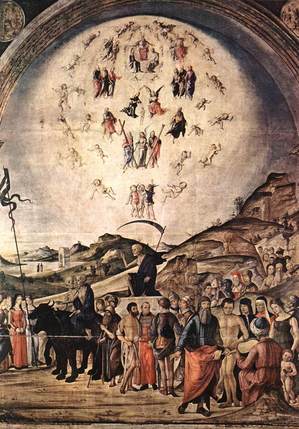 lives of those who have gone ahead of us to receive the Lord’s mercy. Some groups of monks have the custom of praying an entire Psalter for their deceased confreres, concluding each psalm with the verse, “Eternal rest grant unto them, O Lord, and let perpetual light shine upon them.” Generally the Mass and private devotions are all that mark the day in many monasteries.
lives of those who have gone ahead of us to receive the Lord’s mercy. Some groups of monks have the custom of praying an entire Psalter for their deceased confreres, concluding each psalm with the verse, “Eternal rest grant unto them, O Lord, and let perpetual light shine upon them.” Generally the Mass and private devotions are all that mark the day in many monasteries.
The Mass offered today is offered for all the departed monks, nuns, sisters and oblates who persevered in their consecration under Saint Benedict’s guidance. After death, the monks, nuns, sisters and oblates buried in the monastery’s cemetery are not abandoned, not forgotten by their monastic family who remain on earth. The Mass, psalmody, and other prayers, like the rosary or particular litanies to effect in God’s plan their purification and obtain the beatific vision.
O God, giver of pardon and lover of humankind, we beseech your mercy that through the intercession of blessed Mary ever-virgin, and of all the Benedictine saints, our brothers and sisters, relatives and benefactors who have passed out of this life, may be admitted into the fellowship of everlasting bliss.
Faith broadens reason and the virtue of poverty key to Christian life
NEW YORK (CNS) — Msgr. Lorenzo Albacete told a recent gathering at Columbia University that faith broadens reason, making “it more powerful, wider in scope and, in fact, stronger in courage.” “This ‘broadening of reason’ achieves its highest expression in what (Msgr. Luigi) Giussani called ‘the virtue of poverty.’ And this is the proposal we make to the world, to people concerned about economic justice,” the New York priest said in a talk on “Faith & Money: Do They Add Up?” But “the virtue of poverty doesn’t create a bunch of idealists running around,” he said. “If we know history, (we know) people who had been called to a life of poverty … created the great institutions of Western civilization — hospitals, universities, works for the poor, refuges, schools.” Msgr. Giussani, to whom Msgr. Albacete referred, is the late Italian clergyman who founded the Catholic lay movement Communion and Liberation in 1954. A theologian and an author, Msgr. Albacete is the national director of the Communion and Liberation movement in the U.S.
Saint Frances Xavier Cabrini
The first American citizen canonized a saint in 1946, Mother Cabrini founded the Missionary Sisters of the Sacred Heart. Her shrine is in Washington Heights, New York City.
 Inspired by the grace of God, we join the saints in honoring the holy virgin Frances Xavier Cabrini. She was a humble woman who became outstanding not because she was famous or rich or powerful, but because she lived a virtuous life. From the tender years of her youth, she kept her innocence as white as a lily and preserved it carefully with the thorns of penitence; as the years progressed, she was moved by a certain instinct and supernatural zeal to dedicate her whole life to the service and greater glory of God.
Inspired by the grace of God, we join the saints in honoring the holy virgin Frances Xavier Cabrini. She was a humble woman who became outstanding not because she was famous or rich or powerful, but because she lived a virtuous life. From the tender years of her youth, she kept her innocence as white as a lily and preserved it carefully with the thorns of penitence; as the years progressed, she was moved by a certain instinct and supernatural zeal to dedicate her whole life to the service and greater glory of God.
She welcomed delinquent youths into safe homes, and taught them to live upright and holy lives. She consoled those who were in prison, and recalled to them the hope of eternal life. She encouraged prisoners to reform themselves, and to live honest lives.
She comforted the sick and the infirm in the hospitals, and diligently cared for them. She extended a friendly and helping hand especially to immigrants, and offered them necessary shelter and relief, for having left their homeland behind, they were wandering about in a foreign land with no place to turn for help. Because of their condition, she saw that they were in danger of deserting the practice of Christian virtues and their Catholic faith.
Undoubtedly she accomplished all this through the faith which was always so vibrant and alive in her heart; through the divine love which burned within her; and finally, through constant prayer by which she was so closely united with God from whom she humbly asked and obtained whatever her human weakness could not obtain. Although her constitution was very frail, her spirit was endowed with such singular strength that, knowing the will of God in her regard, she permitted nothing to impede her from accomplishing what seemed beyond her strength.
From a homily at the canonization of Saint Frances Xavier Cabrini by Pope Pius XII
God our Father, you called Frances Xavier Cabrini from Italy to serve the immigrants of America. By her example teach us concern for the stranger, the sick, and the frustrated. By her prayers help us to see Christ in all the men and women we meet.
